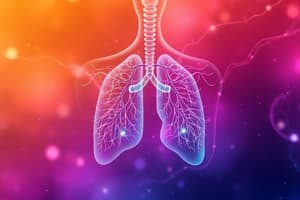Podcast
Questions and Answers
What is the primary function of the respiratory system?
What is the primary function of the respiratory system?
- To protect the lower respiratory tract from foreign particles
- To facilitate the diffusion of gases across alveolar walls
- To transport oxygen and remove carbon dioxide from the body (correct)
- To filter incoming air and warm it to body temperature
Which of the following is not a component of the respiratory system?
Which of the following is not a component of the respiratory system?
- Liver (correct)
- Trachea
- Nose
- Larynx
During the exhalation process, what happens to the oxygenated blood?
During the exhalation process, what happens to the oxygenated blood?
- It diffuses across alveolar walls into capillary blood
- It facilitates the transportation of oxygen throughout the body
- It passes down the trachea and into the lungs
- It returns to the heart, which pumps it back into the system (correct)
What is the main difference between aerobic and anaerobic respiration?
What is the main difference between aerobic and anaerobic respiration?
What is the primary role of the alveoli in the respiratory system?
What is the primary role of the alveoli in the respiratory system?
Which of the following is not a step in the breathing process?
Which of the following is not a step in the breathing process?
What is the initial stage of cellular respiration?
What is the initial stage of cellular respiration?
Which process generates the most ATP during aerobic respiration?
Which process generates the most ATP during aerobic respiration?
What is the primary waste product of fermentation?
What is the primary waste product of fermentation?
Which of the following processes does not require oxygen?
Which of the following processes does not require oxygen?
What is the primary function of the respiratory system?
What is the primary function of the respiratory system?
Which process is involved in the 'Campbell' cycle?
Which process is involved in the 'Campbell' cycle?
Flashcards are hidden until you start studying
Study Notes
Respiration: Understanding the Process of Breathing
Respiration is a vital physiological process that supports life by providing the organism with oxygen and removing carbon dioxide. It consists of two main processes: aerobic respiration and anaerobic respiration, which differ in their efficiency in producing energy from food sources.
Respiratory System
The respiratory system works in conjunction with the circulatory system to ensure oxygen delivery to all cells and carbon dioxide removal. This involves three primary components:
- Nose: Filters incoming air and warms it to body temperature.
- Larynx: Protects the lower respiratory tract from foreign particles.
- Trachea: A conduit for air between the larynx and lungs.
- Lungs: Organs responsible for gas exchange through the bloodstream.
Breathing Process
The breathing process itself consists of a series of steps that facilitate respiration:
- Inhalation: Nasal air passes down the trachea and into the lungs via the bronchial tubes.
- Exhalation: Oxygenated blood returns to the heart, pumping it back into the system, which facilitates the transportation of oxygen throughout the body.
- Diffusion: Oxygen diffuses across alveolar walls into capillary blood, while carbon dioxide diffuses from capillaries into the lungs.
Aerobic Respiration
Aerobic respiration is a metabolic pathway that occurs within mitochondria and requires oxygen to proceed. It involves three stages: glycolysis, the citric acid cycle, and oxidative phosphorylation. During these processes, glucose molecules are broken down to produce energy in the form of ATP.
Glycolysis
Glycolysis is the initial stage of cellular respiration, wherein glucose molecules are split into two pyruvate molecules, releasing a net gain of 2 ATP molecules per glucose molecule.
Citric Acid Cycle
Also known as the Krebs cycle or tricarboxylic acid (TCA) cycle, the citric acid cycle uses the acetyl-CoA produced during glycolysis to generate additional ATP molecules.
Oxidative Phosphorylation
Oxidative phosphorylation is the final step in aerobic respiration, where most of the ATP production occurs. Here, protons generated during electron transport chain reactions drive ATP synthesis via chemiosmosis.
Anaerobic Respiration
Unlike aerobic respiration, anaerobic respiration does not require oxygen and produces less ATP. There are two primary types of anaerobic respiration: fermentation and anaerobic respiration:
Fermentation
Fermentation is a type of anaerobic respiration where cells break down organic compounds without producing much ATP. Instead, it generates lactate, ethanol, or other waste products.
Anaerobic Respiration
Another type of anaerobic respiration is the "Campbell" cycle, where yeast converts sugar into ethanol and CO2.
In conclusion, understanding the basics of the respiratory system, its components, and the processes involved in breathing—such as aerobic and anaerobic respiration—helps us appreciate how life sustains itself through the intricate, interconnected physiological mechanisms that allow organisms to thrive.
Studying That Suits You
Use AI to generate personalized quizzes and flashcards to suit your learning preferences.




